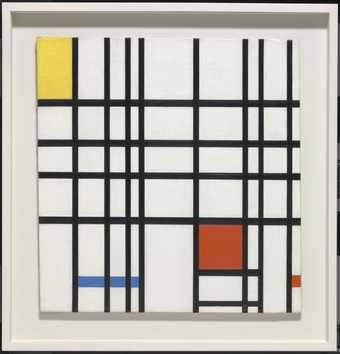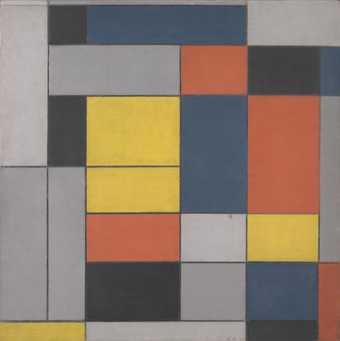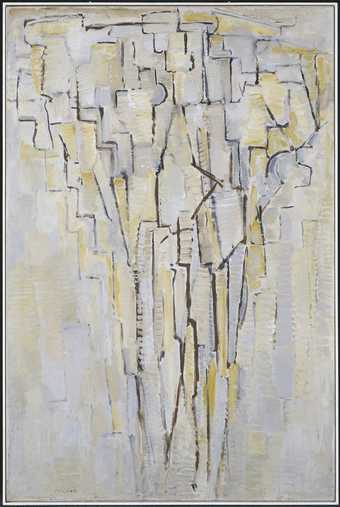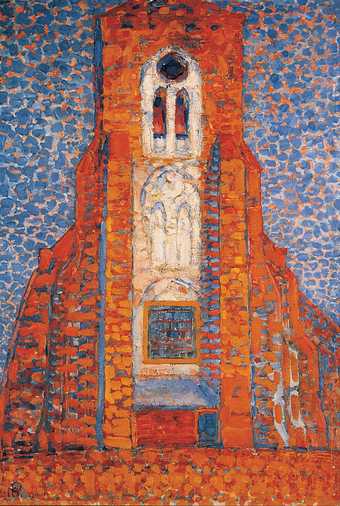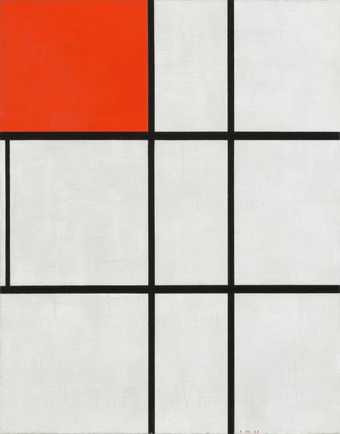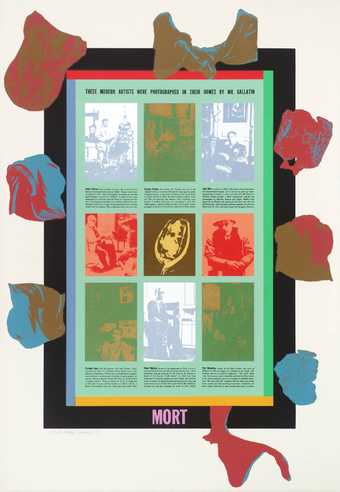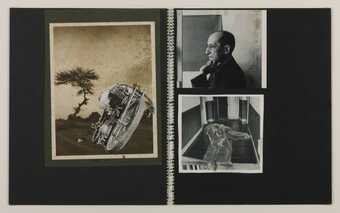In Tate Modern
Artist and Society
FreeIn Tate St Ives
Artist biography
Dutch pioneer of abstract art, who developed from early landscape pictures to geometric abstract works of a most rigorous kind. Born in Amersfoort, Utrecht. Studied painting at the Amsterdam Academy 1892-4 and again, part-time, 1896-7. Friendship with the painter Simon Mans and painted landscapes in the Hague School tradition. Began to work in a more vividly coloured and sometimes pointillist style in 1908, joined the Theosophic Organisation in 1909 and made some works of a Symbolist character. First one-man exhibition with C.R.H. Spoor and Jan Sluyters at the Stedelijk Museum, Amsterdam, 1909. Lived in Paris 1912-14; was influenced by Cubism, which he carried to the point of abstraction. Returned to Holland in 1914 and step by step evolved a more simplified abstract style which he called Neo-Plasticism, restricted to the three primary colours and to a grid of black vertical and horizontal lines on a white ground; associated with van Doesburg in the de Stijl movement 1917-25. Lived 1919-38 in Paris where he joined the group Abstraction-Création in 1931. Moved to London 1938-40, living near Gabo and Ben Nicholson, then in 1940 to New York where he started to develop a more colourful style, with coloured lines and syncopated rhythms. Died in New York.
Published
in:
Ronald Alley, Catalogue of the Tate Gallery's Collection of Modern Art other than Works by British Artists, Tate Gallery and Sotheby Parke-Bernet, London 1981, pp.532-3
Wikipedia entry
Pieter Cornelis Mondriaan (Dutch: [ˈpitər kɔrˈneːlɪs ˈmɔndrijaːn]), after 1906 known as Piet Mondrian (, also US: , Dutch: [pit ˈmɔndrijɑn]; 7 March 1872 – 1 February 1944), was a Dutch painter and art theoretician who is regarded as one of the greatest artists of the 20th century. He is known for being one of the pioneers of 20th-century abstract art, as he changed his artistic direction from figurative painting to an increasingly abstract style, until he reached a point where his artistic vocabulary was reduced to simple geometric elements.
Mondrian's art was highly utopian and was concerned with a search for universal values and aesthetics. He proclaimed in 1914: "Art is higher than reality and has no direct relation to reality. To approach the spiritual in art, one will make as little use as possible of reality, because reality is opposed to the spiritual. We find ourselves in the presence of an abstract art. Art should be above reality, otherwise it would have no value for man."
He was a contributor to the De Stijl art movement and group, which he co-founded with Theo van Doesburg. He evolved a non-representational form which he termed Neoplasticism. This was the new 'pure plastic art' which he believed was necessary in order to create 'universal beauty'. To express this, Mondrian eventually decided to limit his formal vocabulary to the three primary colors (red, blue and yellow), the three primary values (black, white and gray) and the two primary directions (horizontal and vertical). Mondrian's arrival in Paris from the Netherlands in 1911 marked the beginning of a period of profound change. He encountered experiments in Cubism and with the intent of integrating himself within the Parisian avant-garde removed an 'a' from the Dutch spelling of his name (Mondriaan).
Mondrian's work had an enormous influence on 20th century art, influencing not only the course of abstract painting and numerous major styles and art movements (e.g. Color Field painting, Abstract Expressionism and Minimalism), but also fields outside the domain of painting, such as design, architecture and fashion. Design historian Stephen Bayley said: "Mondrian has come to mean Modernism. His name and his work sum up the High Modernist ideal. I don't like the word 'iconic', so let's say that he's become totemic – a totem for everything Modernism set out to be."
This biography is from Wikipedia under an Attribution-ShareAlike Creative Commons License. Spotted a problem? Let us know.
Read full Wikipedia entryArtworks
-
Piet Mondrian Composition with Yellow, Blue and Red
1937–42 -
Piet Mondrian No. VI / Composition No.II
1920 -
Piet Mondrian The Tree A
c.1913 -
Piet Mondrian Sun, Church in Zeeland; Zoutelande Church Facade
1909–10 -
Piet Mondrian Composition B (No.II) with Red
1935 -
Piet Mondrian Evening Landscape with Cows
1906 -
Piet Mondrian Evolution
1911
Artist as subject
-
R.B. Kitaj Mort
1966 -
Sir Eduardo Paolozzi [title not known: page from a scrapbook]
1950s


